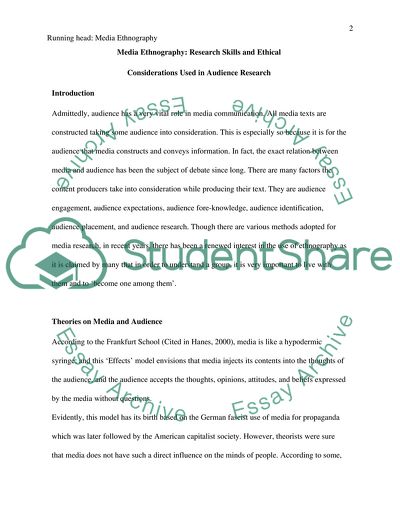Cite this document
(Media Ethnography - Research Skills and Ethical Considerations in Audience Research Literature review Example | Topics and Well Written Essays - 2000 words, n.d.)
Media Ethnography - Research Skills and Ethical Considerations in Audience Research Literature review Example | Topics and Well Written Essays - 2000 words. https://studentshare.org/media/1756745-media-ethnography-has-recently-become-very-popular-with-media-researchers-explain-its-strength-and-weakness-as-media-audience-research-discuss-types-of-studies-it-can-best-investigate-and-those-it-is-less-well-suited-to-research
Media Ethnography - Research Skills and Ethical Considerations in Audience Research Literature review Example | Topics and Well Written Essays - 2000 words. https://studentshare.org/media/1756745-media-ethnography-has-recently-become-very-popular-with-media-researchers-explain-its-strength-and-weakness-as-media-audience-research-discuss-types-of-studies-it-can-best-investigate-and-those-it-is-less-well-suited-to-research
(Media Ethnography - Research Skills and Ethical Considerations in Audience Research Literature Review Example | Topics and Well Written Essays - 2000 Words)
Media Ethnography - Research Skills and Ethical Considerations in Audience Research Literature Review Example | Topics and Well Written Essays - 2000 Words. https://studentshare.org/media/1756745-media-ethnography-has-recently-become-very-popular-with-media-researchers-explain-its-strength-and-weakness-as-media-audience-research-discuss-types-of-studies-it-can-best-investigate-and-those-it-is-less-well-suited-to-research.
Media Ethnography - Research Skills and Ethical Considerations in Audience Research Literature Review Example | Topics and Well Written Essays - 2000 Words. https://studentshare.org/media/1756745-media-ethnography-has-recently-become-very-popular-with-media-researchers-explain-its-strength-and-weakness-as-media-audience-research-discuss-types-of-studies-it-can-best-investigate-and-those-it-is-less-well-suited-to-research.
“Media Ethnography - Research Skills and Ethical Considerations in Audience Research Literature Review Example | Topics and Well Written Essays - 2000 Words”. https://studentshare.org/media/1756745-media-ethnography-has-recently-become-very-popular-with-media-researchers-explain-its-strength-and-weakness-as-media-audience-research-discuss-types-of-studies-it-can-best-investigate-and-those-it-is-less-well-suited-to-research.


